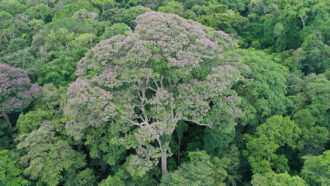amino acids: Simple molecules that occur naturally in plant and animal tissues and that are the basic building blocks of proteins.
bacteria: (singular: bacterium) Single-celled organisms. These dwell nearly everywhere on Earth, from the bottom of the sea to inside other living organisms (such as plants and animals). Bacteria are one of the three domains of life on Earth.
chemical: A substance formed from two or more atoms that unite (bond) in a fixed proportion and structure. For example, water is a chemical made when two hydrogen atoms bond to one oxygen atom. Its chemical formula is H2O. Chemical also can be an adjective to describe properties of materials that are the result of various reactions between different compounds.
corpse: The body of a dead human. Also sometimes used to describe the remains of some inanimate object (such as a star).
dimethyl disulfide: A pair of methanethiol molecules that have been linked together. The result is a very stinky chemical, which smells like rotting meat. It's toxic to many organisms. That’s led to dimethyl disulfide being developed as a soil fumigant that farmers can use to kill weeds, parasitic nematodes (tiny roundworms) and plant pathogens that live in soil.
DNA: (short for deoxyribonucleic acid) A long, double-stranded and spiral-shaped molecule inside most living cells that carries genetic instructions. It is built on a backbone of phosphorus, oxygen, and carbon atoms. In all living things, from plants and animals to microbes, these instructions tell cells which molecules to make.
dung: The feces of animals, also known as manure.
duplication: The process of copying something.
evolution: (v. to evolve) A process by which species undergo changes over time, usually through genetic variation and natural selection. These changes usually result in a new type of organism better suited for its environment than the earlier type. The newer type is not necessarily more “advanced,” just better adapted to the particular conditions in which it developed. Or the term can refer to changes that occur as some natural progression within the non-living world (such as computer chips evolving to smaller devices which operate at an ever-faster speed).
gene: (adj. genetic) A segment of DNA that codes, or holds instructions, for a cell’s production of a protein. Offspring inherit genes from their parents. Genes influence how an organism looks and behaves.
halitosis: This is the medical term for bad breath. It’s not a disease but a symptom of some stinky chemistry occurring in the mouth. It may trace to diet (such as smelly foods, such as garlic) or the stinky emissions of bacteria responsible for a range of conditions, but especially for diseased gums or teeth.
molecule: An electrically neutral group of atoms that represents the smallest possible amount of a chemical compound. Molecules can be made of single types of atoms or of different types. For example, the oxygen in the air is made of two oxygen atoms (O2), but water is made of two hydrogen atoms and one oxygen atom (H2O).
oral: An adjective that refers to things in or affecting the mouth.
organism: Any living thing, from elephants and plants to bacteria and other types of single-celled life.
pollinate: To transport male reproductive cells — pollen — to female parts of a flower. This allows fertilization, the first step in plant reproduction.
shrub: A perennial plant that grows in a generally low, bushy form.
species: A group of similar organisms capable of producing offspring that can survive and reproduce.









